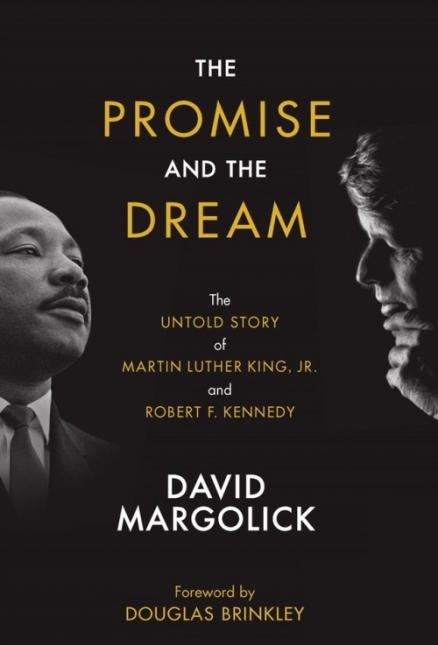The Promise and the Dream: The Untold Story of Martin Luther King, Jr. and Robert F. Kennedy
- By David Margolick
- RosettaBooks
- 400 pp.
- Reviewed by Talmage Boston
- April 26, 2018
An intelligent, nuanced look at two men who helped define the 1960s.

Every so often, a history book that's released in time for its important subject's anniversary date actually exceeds expectations. Such is the case with David Margolick's The Promise and the Dream: The Untold Story of Martin Luther King, Jr. and Robert F. Kennedy, which arrives 50 years after the two icons' assassinations in 1968.
Is the full accounting of the connection between these men an untold story? Yes, and Margolick is the perfect author to tell it since he has already established himself as a top-tier civil-rights historian with the gift for profiling two lives (one white, one black) in a single book. He has done it previously with Elizabeth and Hazel: Two Women of Little Rock (about the girls in the famous photo where the white girl is screaming at the black girl as Little Rock Central High School was integrated in 1957) and Beyond Glory: Joe Louis vs. Max Schmeling, and a World on the Brink.
The author succeeds in meeting the daunting challenge caused by the inconvenient truth that, although King and Kennedy were both civil-rights and anti-war heroes in the same era, their paths rarely intersected.
And when they did, sparks did not fly.
In the book's foreword, Douglas Brinkley describes the pair as “compatriots, but not colleagues; allies, but not friends." And on the penultimate page, Andrew Young acknowledges that theirs was a "distant camaraderie."
Margolick connects the close-yet-disparate dots best of all:
"That two men whose interests and passions so overlapped interacted so little is but another illustration of the enduring chasm between the races, one which, for reasons of sentimentality, practicality, and shame, our culture has had every reason to minimize. Thanks to their common goals and trajectories and calendars, they came to belong to the ages in tandem, and are linked as no other black man and white man in the history of civil rights has ever been. In the popular mind, whatever kept them apart has evaporated. They have become a team. It isn't only in the afterlife that they are together."
Given the distance between them, bringing King and Kennedy together in one book is a masterstroke that allows for a more complete analysis of two key figures in the American experience during the 1960s. While operating largely independently of each other, both men pushed hard on the envelope in pursuing their shared missions of advancing civil rights and condemning American involvement in the Vietnam War.
Knowing what's coming in 1968, Margolick still manages to keep the tension ratcheted up as he provides the highlights of their rollercoaster-like lives.
After President John F. Kennedy's death on November 22, 1963, Robert went "from being the second most powerful person in the United States to a lame duck Attorney General," writes Margolick. Shortly thereafter, somehow, some way, he became liberated from his brother's shadow and was transformed by the fruits of his constant efforts to grasp the frustration and anger of African Americans, who began speaking (and acting) out like never before. As the decade went on, Old Ruthless Bobby became New Empathetic Bobby. With that startling change, his star power took off.
Conversely, King went from being the Great American Hero — recognized as Time magazine's "Man of the Year" in 1963; the Nobel Peace Prize winner in 1964; and the leader of the march for voting rights from Selma to Montgomery in March 1965 — to being perceived as no longer relevant because of his inability to lead the Civil Rights Movement beyond the South, and as an almost crazed agitator against America's involvement in the Vietnam War.
So desperate was King to stay on the public's radar screen that he delivered over-the-top anti-war statements advocating an alliance between North and South Vietnam and praised Communists for their help with the Civil Rights Movement. Such remarks made media leaders and some supporters question his stability at a time when friends and family were concerned over his spiraling depression.
In the middle of the action was the great American villain of the 1960s: FBI director J. Edgar Hoover, who despised and slandered both men and did his best to impede their progress. And all of this pre-1968 interpersonal and interracial conflict took place while King and Kennedy constantly obsessed over death: MLK over his own anticipated murder, and RFK over his brother's assassination.
Momentum builds with each chapter as the dramatic peaks and valleys of the two martyrs' lives crescendo until the climactic shots ring out from the guns of James Earl Ray and Sirhan Sirhan. With those fateful blasts, hopes for a more enlightened country crashed and burned.
Tom Brokaw was asked recently which year in American history compares closest to the challenges facing us now. His answer: 1968. Now, as then, we aspire for racial equality, social justice, a logical balancing of government spending on guns and butter, and keeping weapons out of murderers' hands.
Unlike 2018, the United States had heroes to champion these causes in 1968. In today's void, attempting to refresh the collective memory of what courageous moral leadership looked like a half-century ago is a highly valuable exercise that's fulfilled by David Margolick.
Talmage Boston is a historian and attorney in Dallas, Texas, whose most recent book is Cross-Examining History: A Lawyer Gets Answers from the Experts About Our Presidents (Bright Sky Press 2016, foreword by Ken Burns).

